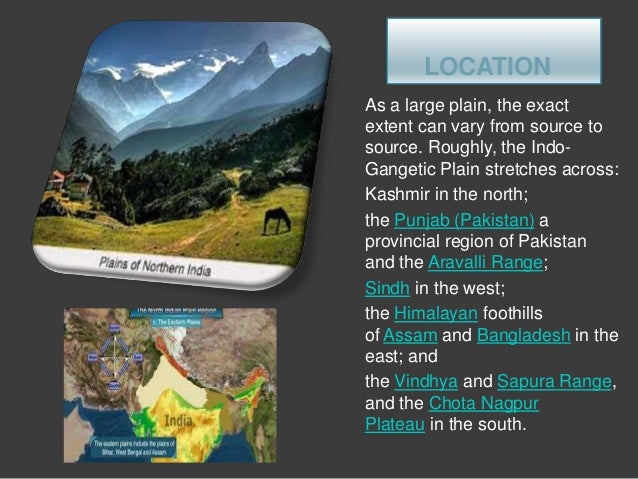Ppt On Northern Plains Of India
Ppt Physical Features of India - Free download as Powerpoint Presentation (.ppt), PDF File (.pdf), Text File (.txt) or view presentation slides online. Scribd is the world's largest social reading and publishing site.
Plains of Northern India, also known as or the North Indian River Plain, are a flat and enormous plain. These plains extend in the east-west direction and are bounded in between the Himalayan in the north and in the south.

These plains form an unbroken belt of alluvium varying in thickness from east r Plain to and northern. Sutlej Plain in the west, the Ganga Plain in the middle and the Brahmaputra Plain in the east constitute the Plains of Northern India.The Thar is located in the west of the being largely a plain formed partly by corrosion and partly by deposition is also included in the Plains of Northern India. These plains continue to the west beyond Punjab and and merge into the Indus Plains in neighbouring country Pakistan.Extension of the Plains of Northern IndiaPlains of Northern India, also known as the Gangetic Plains, is situated in the southern Himalayan Region. The Northern Plains spreading from Assam to Punjab has a length of around 2400 km and the width ranges between 150 km to 300 km, varying in different regions.
It can be found in Bihar, Punjab, parts of and.Features of Plains of Northern IndiaPlains of Northern India are consistently level plains without any interruption except for a few outliers of the Aravalli Mountain Range, such as, in the environs of Delhi. Formerly deep trenches of around 6 to 8 km in depth, these plains outline the isolated low hills or ridges and come out of the adjacent alluvium as islands in the ocean.
The trench was formed as a fore deep, when the Himalayas rose as fold mountains. This east-west depression received drainage from the in the north and the plateau in the south.Owing to continued silting, the depression was filled up with sediments. Stability in the level of these plains is mainly due to two basic facts. Firstly, no earth movement disturbed their flatness later and secondly the deposition took place in water. The watershed that divides the Sutlej Plain from the Ganga Plain is low as one enters the Haryana-Punjab Plain from the Uttar Pradesh Plain.Division of Plains of Northern IndiaThe Plains of Northern India are generally divided into 3 river systems- The Sutlej plain drained by the Indus, The Ganga plain drained by the Ganga and The Brahmaputra valley drained by the Brahmaputra.Sutlej PlainLess than 1/3rd of the Indus basin is situated in India (, and Punjab). It is approximately 2900 km long and its primary tributaries include the,. These rivers unite together before finally merging the in the.

These rivers have turned the Plains of Northern India pretty productive and it now bears the testimony of the densest systems of canals.The Sutlej Basin is situated in the west of the Northern plains covering Haryana, Punjab, as well as parts of. Beas, a tributary of Sutlej, adjoins the river at Harike. In the Sutlej Basin, like, gram, and are cultivated. Rice and wheat, 2 of the major crops are supplied from here, to the rest of the country.Ganga PlainThe major portion of the Plains of Northern India consists of tile. It extends from the eastern margin of the Punjab in the west to Bangladesh border in the east. This is an extensive plain encompassing such as Uttar Pradesh, Bihar and.has two primary origins in the Himalaya the and the.
Both merge in and flow as the Ganga afterward. It enters the northern plains at. Joins it in Allahabad., and in turn join the Yamuna River. They all stream through the Malwa Plateau before entering into the northern plains. The is the only big river that joins Ganga immediately from the southern plateau. Further east, the, irrigating the entire region of, joins the, another.The Himalayan Rivers uniting with the Ganga downstream of from west to east comprise of the,.
The Ganga forms a great on its mouth.Brahmaputra PlainBrahmaputra initiates in Tibet near the source of the Indus River and Sutlej River. Is longer compared to the Indus, most of its course lying in Tibet.
It streams parallel to the Himalaya Mountains in Tibet, where it is referred to as Tsangpo. In it is called Dihang. After the convergence of the, Dihang and, it is named the Brahmaputra. Leaving a huge volume of water, it also transports a gigantic amount of silt with it accumulating debris which paves the way for a fertile land with alluvium soil.Composition of Northern Plains of IndiaPlains of Northern India have been formed by the deposition of alluvia brought by the rivers. The main rivers of the region bring it down from the Himalayas in the north and the peninsular plateau in the south. Such a plain is also termed as alluvial plain that is rich in.
The rivers being heavily charged with boulders, sand and mud unexpectedly loosen in speed as they debouch on these plains depositing their load in the form of gravel fans along the foot of the Himalayan ranges.The southern edge of the Gangetic Plain is broken by several gorges turning the productive alluvial land into unusable barren waste lands. In states of Punjab, Haryana and Uttar Pradesh, which is fed by deficient rain, the main rivers of the region have been tapped for irrigational purposes.The Plains of Northern India are very essential and have their great contribution in the economic development of the country. The land, being even, has stimulated and sustained the growth of improved and.(Last Updated on: ).
Recently Updated Articles in Geography of India.Rainforests of India are mainly located in the north-eastern state of Assam. They are also found in the Andaman & Nicobar Islands and the Western Ghats. These forests are getting rapidly depleted and immediate steps need to be taken conserve the rain forests of India.The origin of Godavari River is at the Trimbakeshwar Temple in the district of Nasik in the Indian state of Maharashtra. It is a tirtha sthaan known as Kushavartham. The Brahmagiri hill is from where this holy river originated.The tributaries of Krishna River are the main source of water in the Western Ghats. The Krishna is one of the longest rivers.
In terms of water inflows and river basin area, the river comes after the Ganga, Godavari and Brahmaputra.The Sahyadris is a range of mountains in southwestern India, also known as the 'Western Ghats'. It has very rough topographical features that include rocky mountains, pinnacles and extensive forest region. It is also known as the Great Escarpment of India.Somasila Dam is a dam constructed across Pennar River near Somasila, in Nellore District of Andhra Pradesh. It is an important project because it covers a huge area of irrigation scheme. Many towns and cities are benefited by receiving the drinking water facilities from this project.Subscribe to Free E-Magazine on Reference.
